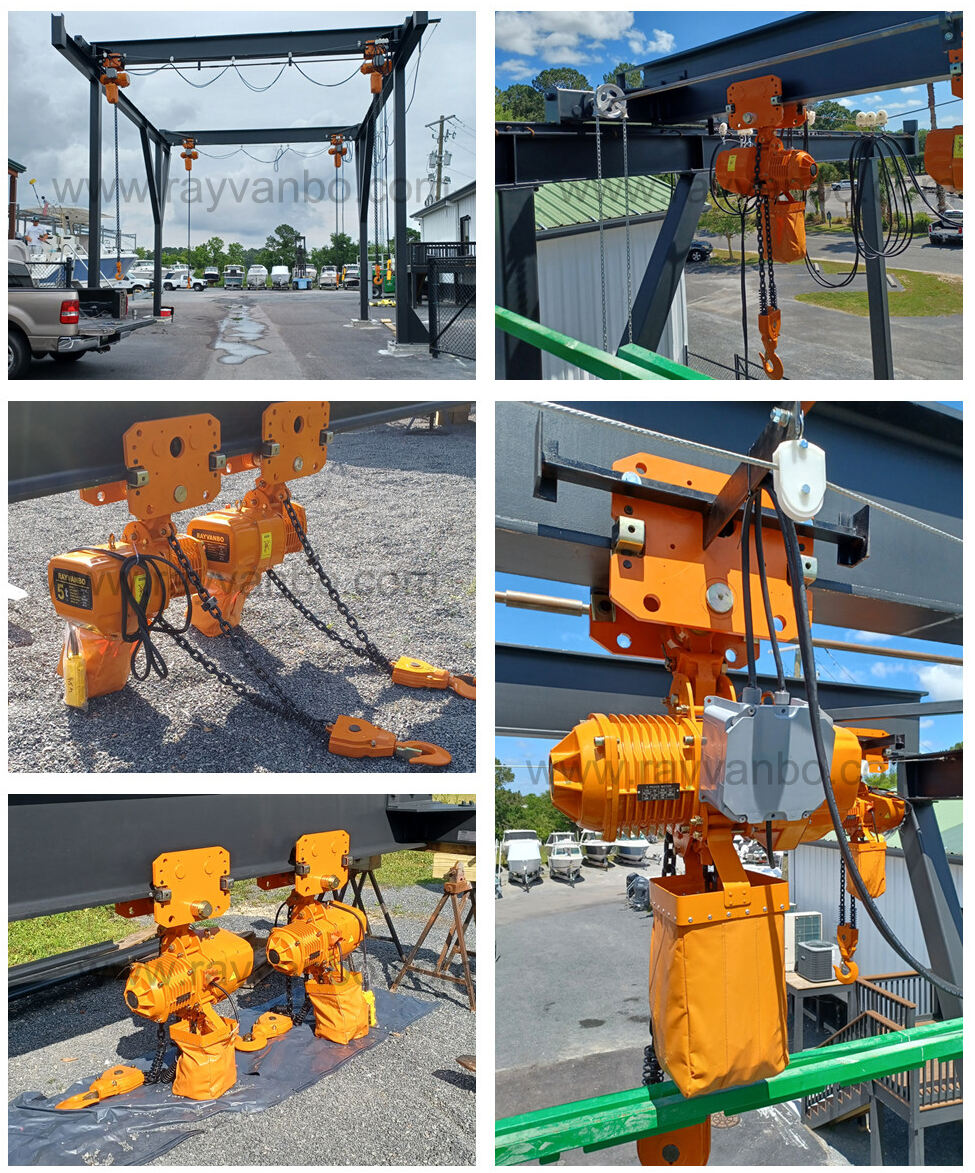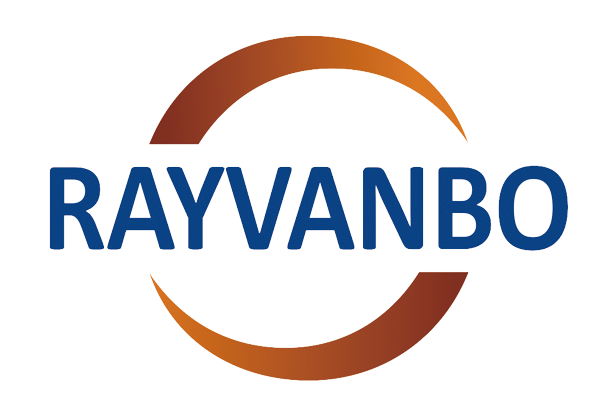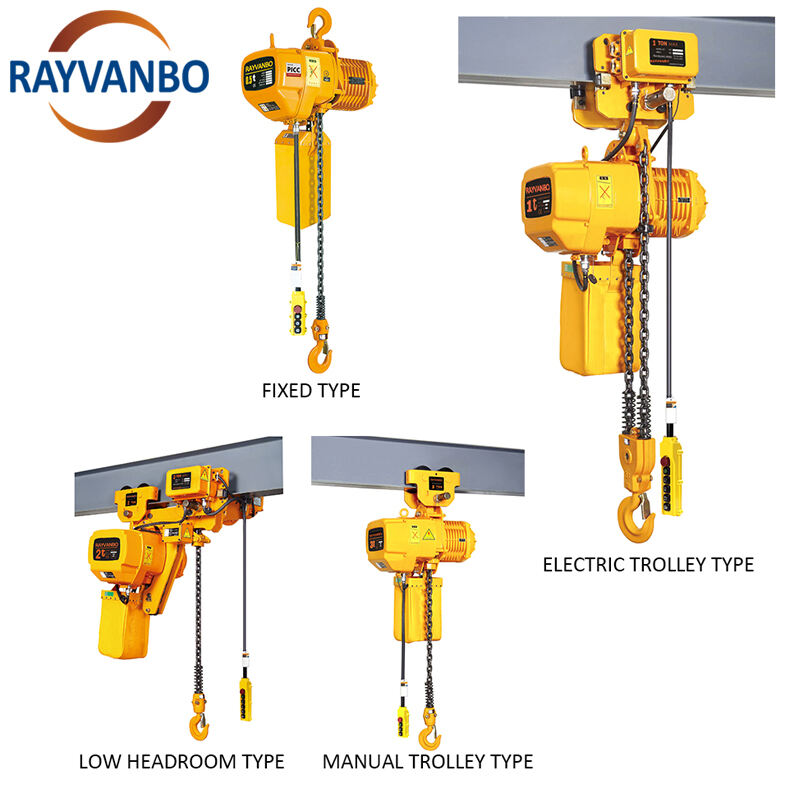Əsas Texniki Xüsusiyyətlər Elektrik Zincir Yuvarlayıcıları
Yüklü Kapasitet və Yüksəltmə Hündürsüyü Tələbləri
Elektrik zəncirli vinçin yüklənmə qabiliyyətini faktiki olaraq qaldırılması lazım olan yüklə uyğunlaşdırmaq həm təhlükəsizlik, həm də işin düzgün yerinə yetirilməsi üçün çox vacibdir. Şirkətlər bunu səhv etdikdə, avadanlıqların zədələnməsi və təsərrüfatda ciddi qəzalar yarada biləcək təhlükəli vəziyyətlər yaranır. Əksər müasir vinçlər dizaynından asılı olaraq 1 tondan bir neçə tona qədər yükləri qaldıra bilir. Məsələn, montaj xətti işləri – çoxlu müəssisələrdə gündəlik işlərdə 1 tonlıq modellər kifayət qədər hesab olunur. Lakin daha ağır materiallar və ya böyük cisimlərlə işləyərkən əksər sənaye müəssisələri üçün ən azı 2 tonla qiymətləndirilən modellərə keçid vacib hala gəlir. Gündəlik əməliyyatlarda yaranan hansı qaldırma çətinlikləri ilə qarşılaşılanın dəqiq bilinməsi doğru avadanlığın seçilməsində ən böyük fərqi yaradır, işçilərin işin gücü vinçin gücü ilə müqayisədə yetərli olmadığından xəbərsiz qaldığı və yağını çıxan vəziyyətləri qarşısını almağa kömək edir.
Qaldırma hündürlüyü əməliyyatların necə yaxşı işlədiyini çox təsir edir. Vinçin zənciri hər bir nöqtə arasındakı mövcud şaquli məkan üçün kifayət qədər uzun olmalıdır, əks halda işçilər əşyaları əl ilə daşımaqla vaxt itirirlər. Biz həqiqətən də hər həftə müəssisələr üzrə saatlarla vaxt qənaət edən düzgün qaldırma hündürlüyünə nail olan real nümunələr görüb. OSHA və ANSI kimi qruplardan gələn təhlükəsizlik qaydaları yalnız rəsmi sənədlər deyil, onlar həmçinin müəyyən iş yerlərində avadanlıqların təhlükəsiz şəkildə hansı yükləri daşıya biləcəyini müəyyən edir. Bu standartlara əməl edən müəssisələr yalnız yoxlamalardan uzaq qalmır, həm də hamı üçün daha təhlükəsiz iş şəraiti yaradırlar. Ağıllı biznes sahibləri bilirlər ki, bu təlimatlara əməl etmək yalnız qanuni deyil, praktiki cəhətdən də məntiqlidir.
Enerji Təchizat Seçimləri: Voltaj və Uzaqdan Idarəetmə Inteqrasiyası
Elektrik zəncirli vinçlər müxtəlif enerji mənbələri ilə təchiz olunub və hər biri müəyyən vəziyyətlərdə digərlərindən daha yaxşı işləyir. 110 V, 220 V və 380 V kimi standart gərginliklər ev mağazalarından başlayaraq böyük istehsalat müəssisələrinə qədər müxtəlif işlər üçün lazım olan müxtəlif enerji miqdarlarını təmin edir. Vinçin istifadə olunacağı yerdə mövcud olan elektrik növünün yoxlanılması vinçin düzgün işləməsi və gələcəkdə problem yaratmaması üçün əhəmiyyətlidir. Gərginliyin düzgün seçilməsi əhəmiyyətlidir, çünki daha aşağı gərginlik seçimindən istifadə tez-tez mağaza və ya qarajda kiçik işlər zamanı enerji qənaəti təmin edir. Bir çox texniklər vinçin gərginlik tələblərinin faktiki iş həcminə uyğunlaşdırılmasının həm səmərəlilikdə, həm də uzunmüddətli xərclərdə real fərq yaradığını müşahidə edirlər.
Elektrik zəncirli vinçlərə pult texnologiyasının əlavə edilməsi onları daha təhlükəsiz edir və ümumi iş prinsipini yaxşılaşdırır. Operatorlar ağır yüklərin yanında durmadan əməliyyatları daha asan həyata keçirə bilərlər. Pulsuz idarəetmə sistemləri işçilərin təhlükəsiz məsafədə qalmaqla yenə də qaldırma əməliyyatlarını idarə etməsinə imkan verir. Bu texnologiyaların müasir enerji sistemlərinin inkişafına uyğun şəkildə inteqrasiya edildiyini müşahidə edirik. Akkumlyatorla işləyən modellər yayılmaqda davam edir, bəzi modellər isə prosesin müəyyən hissəsini avtomatlaşdıran ağıllı sistemlərə qoşula bilir. Anbar operasiyaları və ya tikinti sahələrində işləyən şəxslər üçün bu cür pult funksiyalarına malik vinçlər artıq yalnız rahatlıq deyil, həm də müasir təhlükəsizlik standartları və iş axınının səmərəliliyi üçün vacibdir.
İşleyiş Tələbləri və Performans Faktorları
Davamlı Atölye İstifadəsi üçün Məsuliyyət Çüklünü Anlamaq
Davam edən iş üçün düzgün elektrik zəncirli vinçin seçilməsi əsasən iş dövrünün nə demək olduğunu bilməyə əsaslanır. Əsasən bu göstərir ki, vinç soba qızmadan əvvəl nə qədər uzun müddət işləyə bilər. Əksər istehsalçılar bu dövrləri üç əsas qrupa ayırırlar: bəzən istifadə, mülayim işlədilmə və ağır iş şəraiti. Bu kateqoriyalar sadəcə reklam terminləri deyil, həqiqi dünya şərtlərinə uyğun avadanlıq seçərkən onların əhəmiyyəti var. Bir gün ərzində yüngül qaldırma işləri aparan anbar üçün lazım olan şey, maşınların saatlarla dayanmadan işlədiyi metallurgiya zavodunda istifadə olunandan fərqlənəcəkdir.
Qaldırılması lazım olan çəki, hündürlüyü və avadanlıqdan istifadə tezliyi biz duty cycle (yük faktoru) adlandırdığımız şeyi müəyyən edir. Tonnalarla material ilə işləyən və gündən-günə istifadə olunan ağır sənaye qaldırıcılarını nəzərə alın? Onlar sıxlıq dövrü reytinqinin çox yüksək olmasına ehtiyac duyurlar ki, iş yükü artdıqca sıradan çıxmamasınlar. Bəzi mütəxəssislər çətin duty cycle reytinqi ancaq zavodlar və ya anbarda kimi yerlərdə mənası var, çünki orada işlər heç dayanmır. Biz çox sayda mağazanın adi duty cycle avadanlıqlarının bu cür şəraitdə zamanla sıradan çıxması ilə bağlı problemlə üzləşdiyini gördük.
Krant spesifikasiyyatlarını iş nöqtələriniz ilə uyğunlaşdırmaq çox vacibdir, çünki funksiya dövr reytinqlərindən qarşı çıxmaq texnikaların itkininə və təhlükəli vəziyyətlərin yaranmasına səbəb ola bilər. Bu uyğunlaşdırılma imkan verir ki, elektrik zincir kranınız gözlənilməz dayandırma məsafələrindən özəlliklənərək təhlükəsiz və effektiv şəkildə işləsin.
Yükləmə sürəti və dəqiqlik materialların köçürülmesində
Qaldırma sürəti ilə dəqiqlik arasındakı balans materialların idarə edilməsi əməliyyatlarında əsaslı amildir. Müxtəlif vəzifələr müxtəlif tənzimləmələr tələb edə bilər — qaldırma sürəti məhsuldarlığı artırır, məsələn montaj xətlərində, lakin dəqiqlik tikinti sahələrində və ya zərif materiallarla işləyərkən vacibdir.
Tipik yüksəltmə sürətləri ən çox dəqiqlik üçün yüklərin pozisiyona yerləşdirilməsi zamanı yavaş sürət tərcih edilir, lakin tekrarlanan və yüks məhsul rəhbərliyi prosesləri üçün daha sürətli sürətlər istifadə olunur. Elektrik zincir kəpazlarında istifadə olunan güncəl xüsusiyyətlər dəyişən sürət nümayişləri və yumşaq başlama mekanizmləri daxildir. Bu yeniliklər dəqiqliyi mükəmməl şəkildə ayarlamaq üçün kömək edir və iş sürəti saxlanılır.
Sürət və ya dəqiqlik arasında seçim etmək, nə cür tətbiq növündən asılıdır. İdarə olunan yüklərin növü, iş yerindəki şəraiti və hansı vəzifələrin yerinə yetirilməsi vacibliyi materialların səmərəli hərəkət etdirilməsi üçün ən yaxşı konfiqurasiyanı müəyyən etməkdə böyük rol oynayır. İnsanlar bu elementlərin necə qarşılıqlı əlaqədə olduğunu başa düşdükdə, əslində gündəlik əməliyyatlarla yaxşı işləyən avadanlıq konfiqurasiyalarını seçməyə meyllidirlər, sadəcə sənədlərdə yaxşı görünən şeyi seçmirlər.
Atəliklə bağlı işçilik və dayanıqlılıq nəzərdə tutulmalıdır
Elektrik kəpazının işlənməsində əsaslı öhdəlik xüsusiyyətləri
İstənilən təmir ustalığında elektrik vinçləri ilə işləyərkən təhlükəsizlik həmişə əsas prioritet olmalıdır. Keyfiyyətli vinçlərin içərisində aşırı yüklənmə qoruyucuları, hamının bildiyi qırmızı təcili dayan düymələri və həmçinin etibarlı təhlükəsizlik tormozları kimi müəyyən əsas qorunma vasitələri mövcud olmalıdır. Aşırı yüklənmə sistemləri əsasən təhlükəsizlik funksiyasını yerinə yetirir və operatorların vinçin nəzərdə tutulmuşdan daha ağır şeyləri qaldırmasına mane olur, bu isə avadanlıqların zədələnməsinə və ciddi təhlükəli zonaların yaranmasına səbəb ola bilər. Həmin təcili dayan düymələri gözlənilmədən baş verən qəzalarda və ya hərəkət edən hissələrə kimsə yaxınlaşanda həyat xilas edici rol oynayır. Təhlükəsizlik tormozlarını da unutmaq olmaz – vinç aktiv şəkildə işləmədiyi zaman əşyaların aniden düşməsini qarşısını alırlar. Uyğun təhlükəsizlik protokollarına əməl etmək yaxşı təcrübə olmaqla yanaşı, işçiləri qəzaların qarşısını almaq və OSHA qaydalarına uyğunluğu təmin etmək üçün təhlükəsizlik məcburidir.
Qəzaların qarşısını almaq üzrə aparılan tədqiqatlar müəyyən təhlükəsizlik xüsusiyyətlərinin nə qədər vacib olduğunu göstərir. Bu gün elektrik vinçlərə quraşdırılmış ağıllı sensorları nümunə göstərmək olar. Bu cihazlar temperaturun dəyişməsi və ya gözlənilməyən yük dəyişikliklərini müəyyən edir və vinçin iş rejimini uyğun şəkildə tənzimləyir. Əsl fayda yalnız təhlükəsizliyi artırmaqla qalmır, həm də ideal olmayan şərtlərdə avadanlıqların daha yaxşı işləməsinə kömək edir. Belə vacib texnologiyaları quraşdırmayan workshop menecerləri gələcəkdə ciddi problemlər yaşaya bilərlər. Biz çatışmayan komponentlər iş sahələrində nasazlıqlara və hətta yaralanmalara səbəb olmuş hallarla tez-tez rastlaşmışıq.
Korrozuya Qarşı Dəyərləndirilmə və Az-Mühitli Dizayn
Elektrik zəncirli vinçlər üçün istiqrətli materialların əhəmiyyəti ondadır ki, onlar təchizata qədərli təsir göstərən təmirxanalarda xüsusilə vacibdir. Paslanmayan polad detallar və xüsusi örtüklərlə işlənmiş səthlər pas və aşınmadan qorunmaq üçün ən yaxşı seçim kimi seçilir. Bu materiallar sənaye mühitində rast gəlinən nəmlik, kimyəvi maddələr və daimi hərəkətə davam gətirə bilir. Bundan əlavə, onlar əvəzlənməsi və ya təmiri tələb olunmadan daha uzun müddət dayanır. Təmir tələbləri baxımından istehsalçılar qeyri-lazımi çətinlikləri minimuma endirən konstruksiyalara üstünlük verməlidirlər. Təchizatın daha uzun müddət iş prinsipinin qorunması istehsalat dövrləri ərzində dayanışların azalmasına və nəticədə vaxt keçdikcə xərclərin qənaət edilməsinə kömək edir və eyni zamanda performans standartlarını qoruyur.
Məlumatlar göstərir ki, korroziyaya davamlı xüsusiyyətlərlə, mühür salınmış yataqlar və möhkəm səth emalı kimi hazırlanmış qaldırıcılar standart modellərdən xeyli uzun ömürlü olur. Təkzib edilməz bir faktor kimi qeyd etmək olar ki, əksər operatorlar tənzimli yoxlamaların və avadanlığın düzgün saxlanmasının qurğunun xidmət müddətinə birbaşa təsir göstərdiyini bilirlər. Şirkətlər bu əsas təmir işlərinə əməl etsələr, elektrik qaldırıcıları daha çox nasazlıqlara yol vermədən işləməyə davam edəcək. Bu isə daha az təmir çağırışı, daha az dayanma və ümumilikdə avadanlıqlara sərf olunan vəsaitin daha yaxşı dəyərini təmin edir. Vaxt keçdikcə qənaət artır və eyni zamanda əməliyyatlar hər gün hamar şəkildə davam edir.

Wuhan Rayvanbo Import & Export Trade Co., Ltd.
Vuhan Rayvanbo İdxalat və ixracat Ticarət şirkəti, elektrik zəncirli vinç biznesində illər ərzində kifayət qədər şöhrət qazanıb. Onlar müxtəlif sənayelərdə həqiqi dünyada istifadə üçün keyfiyyətli qaldırma avadanlıqlarının təhvil verilməsinə xüsusi diqqət yetirirlər. Şirkət, möhkəm konstruksiya, daxili təhlükəsizlik mexanizmləri və qətib şəraitdə belə paslanmaya davamlı materiallardan hazırlanmış müxtəlif elektrik vinçləri təklif edir. Bu maşınlar həm böyük zavodlarda, həm də məkan məhdud olan kiçik mağazalarda quraşdırılsa belə yaxşı işləyir. Vuhan Rayvanbo-nu fərqləndirən cəhət, dizaynlarını daim təkmilləşdirməyə və eyni zamanda etibarlı performans standartlarını saxlamağa sadiq qalmasıdır. Böyük dünyada bir çox şirkət, ən vacib anlarda işləyən vinçlərinə gündən-günə etibar edirlər.
â
Mündəricat
-
Əsas Texniki Xüsusiyyətlər Elektrik Zincir Yuvarlayıcıları
- Yüklü Kapasitet və Yüksəltmə Hündürsüyü Tələbləri
- Enerji Təchizat Seçimləri: Voltaj və Uzaqdan Idarəetmə Inteqrasiyası
- İşleyiş Tələbləri və Performans Faktorları
- Davamlı Atölye İstifadəsi üçün Məsuliyyət Çüklünü Anlamaq
- Yükləmə sürəti və dəqiqlik materialların köçürülmesində
- Atəliklə bağlı işçilik və dayanıqlılıq nəzərdə tutulmalıdır
- Elektrik kəpazının işlənməsində əsaslı öhdəlik xüsusiyyətləri
- Korrozuya Qarşı Dəyərləndirilmə və Az-Mühitli Dizayn
- Wuhan Rayvanbo Import & Export Trade Co., Ltd.

